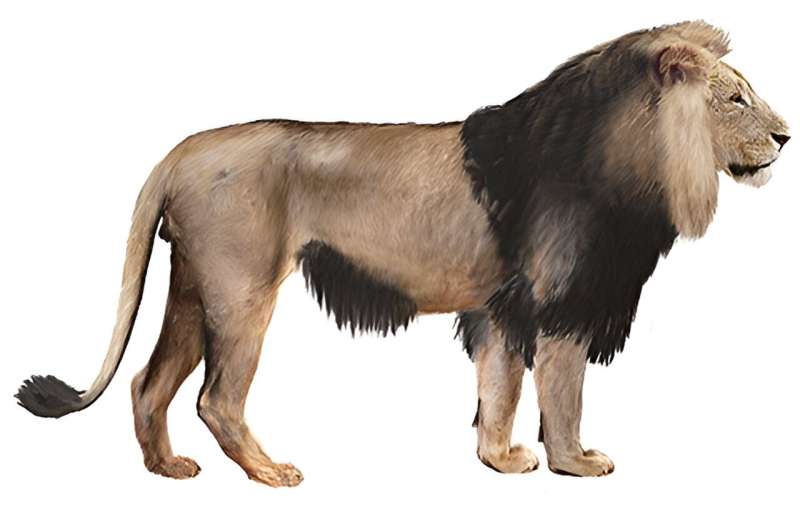This article has been reviewed according to Science X's editorial process and policies. Editors have highlighted the following attributes while ensuring the content's credibility:
fact-checked
trusted source
proofread
Cape lions were genetically diverse prior to extinction, researchers find

Cape lions used to roam the Cape Flats grassland plains of South Africa, in what is now known as Western Cape Providence. When Europeans arrived in South Africa in the mid-1600s, Cape lions, along with many other African carnivores and herbivores, were hunted as agricultural practice to protect livestock and humans. By the mid-1800s, less than 200 years since European arrival, Cape lions had been hunted to extinction.
European naturalists described the Cape lion as having a particularly black mane and as being morphologically distinct. However, alternative depictions and descriptions of Cape lions from Indigenous people report mixed or light mane coloration. To shed light on this discrepancy, a recent study published in the Journal of Heredity, led by a team of researchers from the University of Illinois Urbana-Champaign, compared the genetic diversity and distinctiveness of Cape lions to modern lions across 13 African countries.
The team features researchers from the Carl R. Woese Institute for Genomic Biology, including postdoctoral researcher and first-author Alida de Flamingh, Professor of Anthropology Ripan Malhi (CIS co-leader/GSP/GNDP/IGOH), Professor of Animal Sciences Alfred Roca (EIRH/GNDP), and Associate Professor of Integrative Biology Julian Catchen (CIS/GNDP), along with biologists from Roosevelt University and the Field Museum.
"What's interesting is that the scientific name of the Cape lion, Panthera leo melanochaitus, literally means black mane, but this description was based on a single specimen," said Julian Kerbis Peterhans, an emeritus professor at Roosevelt University. "Historically, we see lots of examples of creatures that are large and attractive like lions, where everybody wants to claim that they'd discovered a new one, without taking into account variation in the population, or whether that species is even unique."
Earlier investigations focused on limited segments of the Cape lion genome, offering the first indication that these lions might not be as distinct as initially believed. However, this study represents the first comprehensive examination of the entire Cape lion genome in comparison to contemporary lion populations across Africa.
The team gathered samples from two Cape lion skulls currently housed at the Field Museum. These skulls were initially showcased at the South African Institute in Cape Town (1828-1838) as integral components of taxidermy mounts. The well-documented history of the skulls allowed the researchers to contextualize the diversity of the Cape lions within a specific time frame.
"Unlike most other Cape lion specimens around the world, these specimens had a traceable history and geographic collection location, so they had a pedigree," said Thomas Gnoske, a Field Museum biologist. "As such, it was a great opportunity and challenge to see what application of the newest genomic methods could tell us about these specimens."
The genomic data collected from the skulls was compared to 118 existing mitogenomes and nuclear genomes of 53 other lions across Africa. Using complimentary genomic analyses, they found that the genome of the Cape lions was diverse and demonstrated genomic links with other lions from both the southern and eastern parts of Africa. While the researchers acknowledge the limitation of having only two Cape lion samples, they underscored that the results indicate that genetic characteristics that Cape lions had are still present in historic and some contemporary populations of lions in these regions in Africa.

"One of the most surprising things was that we found such high genetic diversity in the Cape lion population," said de Flamingh. "Both skulls were from the same small area, yet they had quite different mitochondrial DNA lineages and nuclear genomes. It tells us that there were very genetically diverse lions living in the Cape before they were extirpated."
The researchers also found that the Cape lion genomes exhibited high heterozygosity, and lacked traits commonly associated with small populations and inbreeding—characteristics frequently observed in endangered species facing population decline. This unexpected absence of such traits in the Cape lion genomes is particularly noteworthy, considering how close the skulls' collection was to the species' extinction.
"Contemporary species that are critically endangered and at high risk of extinction, such as the rhino or black-footed ferret, often have really small effective population sizes, which leads to inbreeding and lack of heterozygosity," explained de Flamingh. "The Cape lions didn't have any of those genomic signatures. What this means is that the Cape lions were hunted so rapidly that their genomes didn't have time to accumulate the signatures of long-term small population size."
The richness observed in the Cape lion genome implies that these lions likely exhibited significant phenotypic variation, including diverse mane coloration. This aligns more closely with alternative descriptions and Indigenous perspectives of the species, which the researchers say emphasizes the importance of incorporating diverse knowledge systems in enhancing our understanding of the histories of species.
"For me, the big takeaway from this study does not specifically have to do with Cape lions," said Malhi. "The information we gained from the genomic data and analysis didn't fit what was thought about Cape lions based on colonial descriptions. This study is good example showing that identifying type specimens using information from people who are not originally from that area can result in ignoring diversity in a population that is important for understanding evolution."
The team suggests that this discovery provides insights for shaping future conservation strategies particularly for contemporary lion species in Africa. The results emphasize the importance of trans-country parks and heightened genetic connectivity between populations across Africa in order to maintain genetic diversity and flow.
"Working with museums, such as the Field Museum, is an exciting opportunity to apply ancient DNA analyses to better understand human-animal interactions," said de Flamingh. "I think it's an area that's going to be studied more and more as our genetic technology continues to advance."
More information: Alida de Flamingh et al, Genomic analysis supports Cape Lion population connectivity prior to colonial eradication and extinction, Journal of Heredity (2023). DOI: 10.1093/jhered/esad081
Provided by University of Illinois at Urbana-Champaign





















